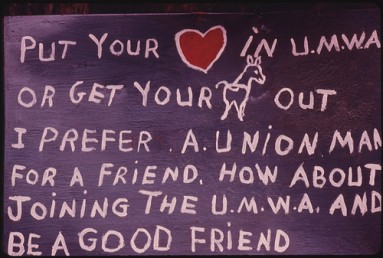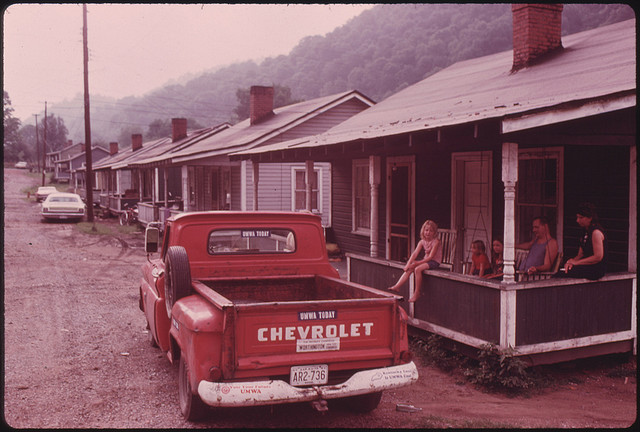It was in Inez, Kentucky, that Lyndon Johnson, standing on the porch of a beat-up little shack, launched the opening salvo in his War on Poverty in 1964. Forty-eight years later, when the voters of Kentucky elected Rand Paul, a libertarian Republican, to the U.S. Senate, their state had an unemployment rate of 10.5 percent, the ninth highest in the country. In the Eastern part of the state — celebrated for its natural beauty but infamous for hosting vicious battles between coal-mine capital and labor — things were even worse, with unemployment reaching 12.4 percent. And this low point was not an aberration from otherwise prosperous years. From 2006 to 2010, the median household income in the U.S. was roughly $52,000 per year; in Kentucky, it was $41,576.
This is the state Rand Paul won in 2010, by 11 points. Some D.C. pundits credited the Aqua Buddha — a satirical deity a college-aged Paul once “worshipped,” bong allegedly in hand, and the focus of an ill-received attack ad from Paul’s opponent — and others, in the wake of the Supreme Court’s Citizens United decision, wanted to credit money. The race saw at least $8.4 million spent by third parties — 65 percent in support of Paul.
What propelled Paul — a man who, if not for his father, would stand as by far the most doctrinaire and unbending libertarian politician on the national political stage — to the “world’s greatest deliberative body”?
The chief reason was the awful economy and the fact that a Democratic president was its nominal steward. Poor economic conditions disheartened Democratic voters and pumped Republican ones full of righteous fury. As a political actor, there’s much Rand Paul can’t do. But righteous fury is one thing he can do — and well. Paul told a story about profligate Washington, self-interested bureaucrats, bourgeois environmentalists, and taxes, taxes, taxes keeping Kentucky voters down. And as has been the case for more than a generation, his Democratic opponent didn’t present an alternative narrative so much as a watered-down variation of the same. Not because he was clueless or stupid. He couldn’t afford not to.
In the universe of Kentucky politics, there is but one Sun, and its name is coal. It’s been this way for nearly 100 years. In the early 1900s, investors with the capital necessary to establish industrial mining operations found an extremely willing partner in Kentucky’s state government. Still reeling from the devastation of the Civil War, Kentucky’s politicians adopted an open-door policy to outside interests, allowing and facilitating land purchase and development by investors from the Northeast as well as from overseas. Their justification was the dream of a New South.
Popular among Southern elites throughout the peak years of the Industrial Revolution, “New South” ideology proposed that the long economically stagnant South would vault to the forefront of the U.S. through industrial capitalism. The money gained from selling access to natural resources — as well as the cheap labor of their largely uneducated, agrarian, and impoverished citizens — would be used to further development. So would go the virtuous circle.
This is how the future came to Kentucky — the same way industrial capitalism has arrived anywhere. In its broad outlines, the New South prescription is no different from what has been called the Washington Consensus model of development: cheap labor, ample resources, outside investment, and a government hospitable to capital. Whether it’s the U.S. South in the 1890s or the global South in 2012, it’s a winning proposition — as long as you’re at the negotiating table. Capitalists and politicians put pen to paper, and the people put their nose to the grindstone.
The consequences for Kentucky were straightforward enough: an economy almost entirely fueled by coal, a mono-economy in which Kentuckians moved from their subsistence farms in their hollers to company towns in their hollers. They worked the mines for generations, until one day they didn’t. The jobs went to locales with cheaper labor and lower expectations. Company towns became ghost towns.
The coal’s still there, albeit in less plentiful quantities. The coal industry, with its influence, wealth, and power, is still there too. And according to state residency records, for 17 years Kentucky was where Rand Paul could be found. But the jobs are gone, long gone, and they aren’t coming back.
***
When he was running for Senate, Rand Paul let slip his ignorance of why, exactly, Harlan County was so famous. He guessed it had something to do with The Dukes of Hazzard or the legendary feud between the Hatfields and the McCoys. He was wrong, twice over. Harlan County first gained widespread notoriety in the 1930s, when relations between the local coal miners’ union and their bosses exploded into a strike that degenerated into guerrilla warfare between union men and hired guns. After those battles — so savage that the governor of Kentucky eventually called in the National Guard — Harlan County was known as “Bloody Harlan.”
Rand Paul didn’t need to let on whether he knew any of this when he won his election. In 1953, national union membership was somewhere around 33 percent; today that number hovers feebly at 11.8 percent. In Kentucky, less than one out of 10 workers belongs to a union, and since 1989, when the Bureau of Labor Statistics first began collected data on state membership rates, almost every year has had lower levels than the last.
We may live in a glorious future of Google Glasses and Tupac holograms, but the fundamentals of politics and power remain stubbornly fixed. Union membership seems to be in terminal decline, and without the counterbalance of organized labor, big business can get nearly anything it wants from government.
As Mother Jones’s Kevin Drum noted about the national political parties,
Politicians don't respond to the concerns of voters, they respond to the organized muscle of institutions that represent them. With labor in decline, both parties now respond strongly to the interests of the rich — whose institutional representation is deep and energetic — and barely at all to the interests of the working and middle classes.
Kentucky politicians “respond strongly to the interests of the rich,” too, and they don’t come any richer than a coal-company lobbyist. The results are conspicuous, like a smoldering crater on the side of a mountain.
Consider Rand Paul’s support for national “right to work” legislation. Like his father before him and countless other self-styled libertarian-leaning politicians, Rand’s antipathy for unions is matched only by his hatred for Washington, Communism or, worst of all worlds, the Communists in Washington. Paul’s mere presence in the Senate is proof enough that saber rattling toward organized labor carries minimal downside.

Paul also supports a coal-extraction method known as mountaintop removal (MTR). As drastic as its name sounds, it’s even more violent, destructive, and reckless in practice[1],
There’s something almost viscerally offensive about the idea of razing mountains for profit. It sounds too much like something out of The Lorax or FernGully. Given the inherent odiousness of inundating citizens with explosions, the thick layer of dirt and dust that wafts over from the worksite, the occasional necessity of moving people off their ancestral homes in order to pulverize the land, the case against MTR would seem easy to make in any public debate. But coal companies have two things on their side that politicians find irresistible: jobs and money.
Unsurprisingly, "jobs" is the mantra repeated with dogged relentlessness by all mountaintop-removal proponents. When that fails, a cynical appeal to bitter xenophobia is often the next rhetorical move, painting reformers, activists, and other opponents of Big Coal as troublemaking outsiders — an old and enduring trope in Kentucky, and the South more generally.
During the campaign, Paul had little to say about MTR besides recommending a name change, claiming it left the land with “enhanced value.” He said, “I don’t think anyone’s going to be missing a hill or two here and there.” But his opponent, state AG Jack Conway, was only marginally better. His comments were just as misguided as Paul’s but lacked the Republican’s clarity and conviction. “I think coal needs to be mined responsibly, and what we need out of our surface mining is to make certain that we’re not burying streams that are the headwaters of the Kentucky rivers. The other thing is, when you permit land, you need to make certain that land use is at the forefront of the permit.” Land use at the forefront of the permit — change you can believe in!
Much of Conway’s fundraising came from unions and other left-of-the-aisle interest groups, but he pocketed what he could get from energy interests too. Besides, unions themselves are no great defenders of the mountaintops. In fact, the line between the union and the coal company nowadays, buried as it is under all that mountaintop debris, can be mighty hard to see. Call it Stockholm syndrome. It was Cecil Roberts, the head of the United Mine Workers of America — not some gold-toothed, cigar-chomping, $100-dollar-bill-alighting coal baron — who said, “The Navy SEALs shot Osama bin Laden in Pakistan and [EPA chief] Lisa Jackson shot us in Washington.”
Voters in Kentucky, then, were offered two choices. Both for mountaintop removal; two good friends of Kentucky coal. It costs money to run a campaign, after all, and Big Coal’s got it. While there were real differences between the two candidates on many issues, both answered the central question of the state’s future — how to build a post-coal economy — essentially the same. Paul blustered about onerous regulation; Conway dissembled about maintaining safe conditions. Neither dared imagine a life out from under the shadow of coal.
All that left Kentuckians to do was take the measure of each man. Either Rand Paul — radical, pugnacious, angry, and self-assured, or Jack Conway — vacillating, evasive, contrived, and opaque. Fifty-five percent of voters went for Paul. If we look at ourselves before we cast a glare their way, can we really blame them? Of course, there’s always the option to choose no one at all. That was the decision nearly six out of 10 Kentuckians were content to make.
